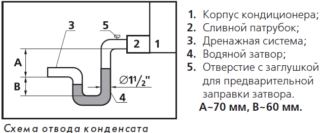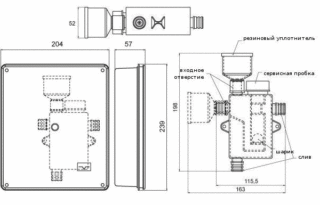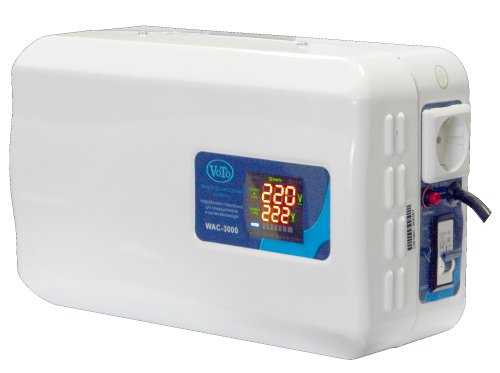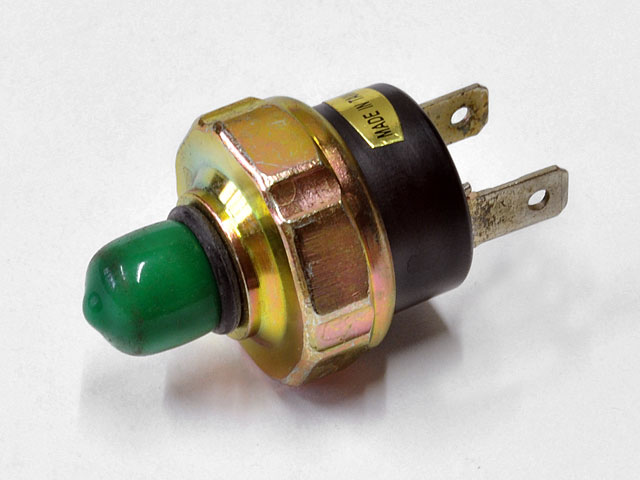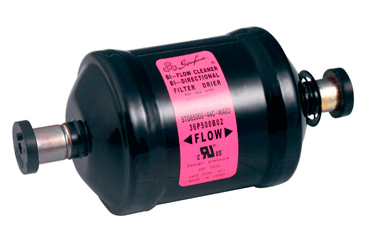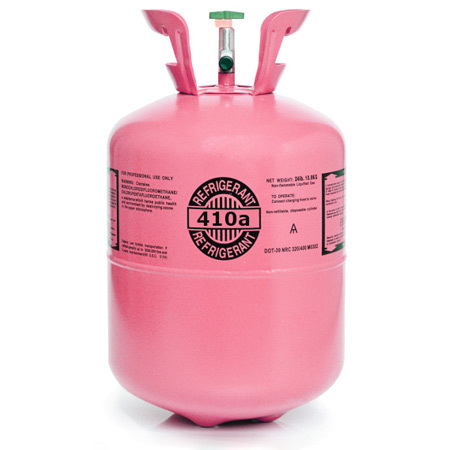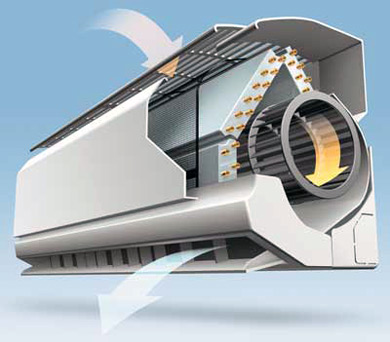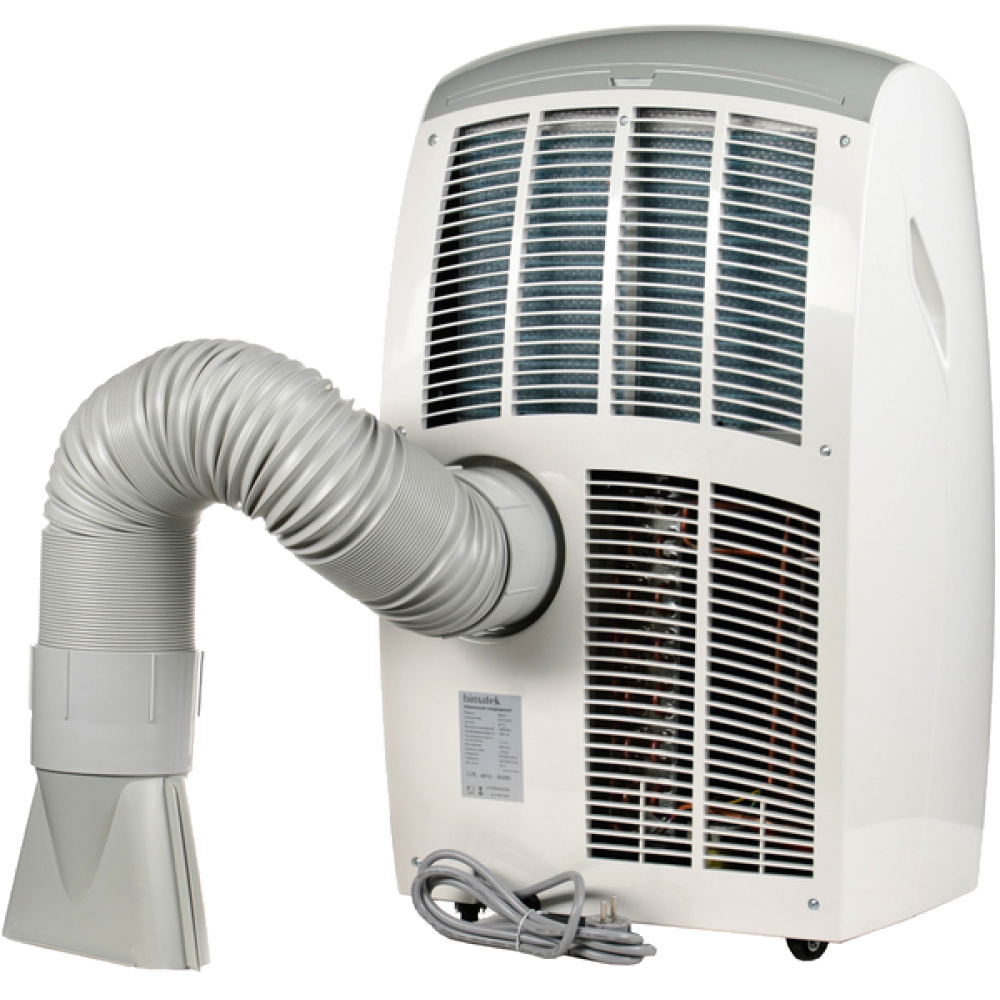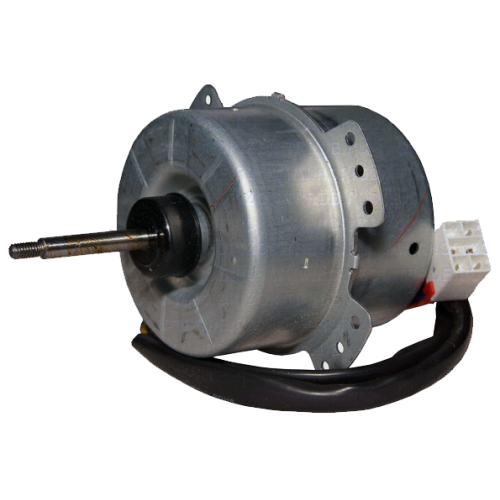Condensation forms during the operation of the air conditioner. To collect moisture, the design of the indoor unit provides a special pallet. Condensate drainage is carried out with a drain hose. According to the rules, climatic equipment for water discharge must be connected to the sewer system. A siphon with a water seal prevents the penetration of unpleasant odors into the apartment.
- Purpose of the device
- How the siphon works
- Types of siphons
- Arched model with a water seal
- Design with a water seal and odor-locking mechanism
- Concealed system
- Dry unit
- How to choose a siphon for draining condensate from an air conditioner
- Drainage system installation
- Main manufacturers
- Hutterer & Lechner
- Vecamo
- McAlpine
Purpose of the device
How the siphon works
A conventional odor trap is U-shaped. In the elbow connecting the inlet and outlet, water remains, which is a barrier to the exit of sewer odors. When using plumbing fixtures, the water in the water seal often changes, the level does not have time to decrease. In the case of an air conditioner, the flow of moisture is uneven, if the equipment does not work, then the condensate does not drain. The odor trap dries up, in the absence of a water barrier, gases penetrate into the room.
A non-return valve for draining the air conditioner helps to prevent an unpleasant situation. The device blocks air and sewerage drains, and the condensate passes freely. An ABS ball or spring diaphragm is used as a locking mechanism.
When the unit is filled with water, the float rises, opening the outlet to the sewer. After leaving, the liquid falls under its own weight, blocking the hole.
Types of siphons
Devices are classified according to two criteria: design and method of moisture removal.
Arched model with a water seal
The standard version is bulky. The height of the water seal should be between 140-320 mm. The branch pipes are made transparent for visual inspection. Outlet diameter 40 mm. A washing machine can be connected to make up the water seal. The model is recommended for increased pressure or vacuum in the drainage pipeline. Among the disadvantages of the unit: large size, favorable environment for the development of bacteria, the likelihood of drying out.
Design with a water seal and odor-locking mechanism
Compact version for flush and surface mounting. The unit is provided with a water seal and an odor-locking mechanism in the form of an ABS ball. When the level of the hydraulic seal drops, the shut-off valve closes the branch pipe. The model is equipped with a cleaning chamber for collecting dirt. The inlet to the siphon is vertical or horizontal, pipe DN32. Horizontal outlet DN40.
Concealed system
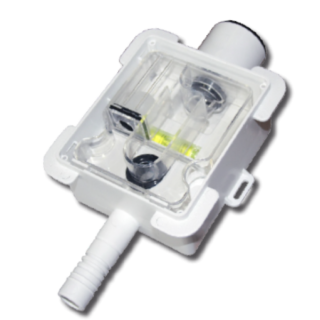
The siphon unit for draining the air conditioner into the sewer is hidden in a plastic box. The unit body is installed in the wall. The type of placement is vertical, the height of the water seal is 50 mm. Case size 100x100x60 mm. Two pipes are connected to the box - the inlet pipe and the outlet to the sewer. Connection of drainage hoses of three diameters is possible: 20, 26, 32 mm. Inside the body there is a transparent cassette with a water seal and an odor-locking device. The valve opens when the condensate passes and drops after the water leaves. The cassette is replaceable, it is independently removed and cleaned of dirt.
The set includes a construction plug and a decorative cover with spring clips. When choosing the place of installation, the requirement is taken into account - the minimum distance between the outlet of the split system and the siphon is 2 m. To service the unit, it is enough to remove the decorative cover.
Dry unit
Using a water seal is a simple and cheap solution to the problem of blocking unpleasant sewer odors. Without regular renewal of the water barrier, its benefits disappear.
Dry odor trap for an air conditioner is a design with a membrane, a swing lock or a tube that acts as a check valve.
The most common option is a molecular memory elastic tube. In the normal state, it is closed and seals the sewer gases. During the passage of water, the tube opens, then returns to its original shape. Advantages of a dry seal:
- compact size;
- due to the smooth surface of the membrane or tube, the device does not clog;
- serves as a reliable obstacle to the spread of odor from the sewer;
- does not freeze in winter;
- the absence of knees ensures high throughput;
- vertical and horizontal installation is permissible.
A dry siphon is used not only for the drainage of air conditioners, it is installed under the bathtubs and sinks in the country.
The second point of classification is the method of condensate outlet:
- vertical release;
- horizontal release;
- combined option.
How to choose a siphon for draining condensate from an air conditioner
Siphons installed for condensate drainage differ in size and design. When choosing a model, several criteria are taken into account:
- Diameter of the outlet for condensate drainage. The drain hose must be sized to match the siphon inlet.
- The free space for mounting the device is estimated. The dimensions of the model may not fit in the allotted area.
- For built-in siphons, the depth of the installation niche in which the unit is installed is estimated.
- The throughput of the unit must correspond to the amount of condensate. The required information is indicated in the specifications of the devices. A siphon with a low flow rate is not suitable for air conditioners with a large condensate volume.
- Rubber seals at the inlet and outlet of the unit ensure the tightness of the connection. If the siphon is placed in direct sunlight, ultraviolet light will quickly render it unusable. In such a situation, hidden installation is necessary.
Drainage system installation
A flexible hose is laid from the drain hole of the indoor unit of the air conditioner. To place it in the wall, a strobe is punched.
The line should not make sharp turns, they impede the uniform flow of fluid. Let's say an angle of 45 °.
To ensure the drainage of condensate by gravity, the hoses are laid with a slope of 1-2 cm per 1 m of length. No sagging of the hoses is allowed.
Before entering the sewer pipe, a siphon with a water seal is installed, which cuts off unpleasant odors. Installation is carried out using crimp nuts. The direction of flow is marked on the body of the unit. The arrow helps you identify entry and exit. The connection to the sewer network is made with a break in the jet. After installation, the system is tested.
Main manufacturers
Hutterer & Lechner
The leader in the production of siphons for air conditioning systems is the Austrian company Hutterer & Lechner (HL).The products are of high quality and simple design. The technology of equipping the units with a water seal and a shut-off ball valve prevents unpleasant odors. The company offers siphons of various models:
- HL 136.2 - siphon with water seal;
- HL 138 - embedded system;
- HL 136 N - a unit with a water seal and a ball odor-locking device.
Vecamo
The Italian firm Vecamo offers an air conditioner siphon that is wall-mounted, allowing easy access to the inlets and outlets. The kit includes connectors to accommodate various drainage hoses. The transparent plastic case provides the ability to monitor the condition of the interior.
McAlpine
McAlpine's MacValve series self-closing drain valve or dry siphon is available in two installation sizes: 32mm and 40mm. A polymer tube is installed in a compact plastic case, which functions as a smell-locking device. Vertical installation is recommended, but horizontal installation is acceptable. In the first case, the throughput is 1.58-275 l / s, in the second it is lower - 0.7-1.7 l / s.
The design of siphons with a non-return valve for draining condensate into the sewer system has been thought out by professionals. It will not be possible to make such a device on your own. The only available option is a simple design with a knee and a water barrier that can dry out at any time.

